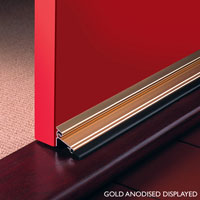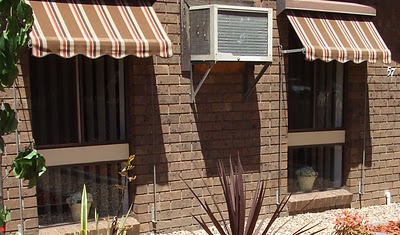People who visit our home during hot and cold weather often comment on the comfortable temperature inside it. Well it is not because we run the air conditioner or heater 24×7, far from it. It is more like a few small actions that we took and continue to practice each day.
Firstly, we took the time to check our roof insulation levels. It is paper pulp type insulation and there is lot of it up there. I made sure that it was level throughout the roof space and that there were no gapes in the coverage. If it was too high in one area I just moved it with a flat board to another lower area. Job sorted and at no cost to me.
When we first moved in we changed over the light fittings to more energy efficient ones, and tried to minimize the number of holes that we cut into the ceiling. Holes mean heat loss on a cold night or heat ingress from the roof cavity during hot days. We repeated this philosophy when we planned and built our kitchen renovation last year. We actually eliminated all the holes in the roof in what was 3 separate rooms. The kitchen is much warmer in winter now, and cooler in summer because of it. We also fitted ceiling fans at both end for additional air movement and in every other room as well.
 Then it was on to weather proofing or draft proofing to ensure that there could be minimal heat loss from our home. It also prevents heat ingress during summer. Drafts and gaps around the doors and windows can account for 25-50% of your homes heat loss. It was quite an easy thing to remedy as the window frames were all in good condition with no gaps and we only needed to consider two of the three outward facing doors as the glass sliding door was already draft proofed. To close up the gaping spaces between the door jams and the doors, I used foam strips from the hardware store and ran it all around the frame on both doors. Then I installed a draft stopper at the bottom of each one which eliminates the gap underneath each door as it closes. Total cost was about $50 for both doors. I tested each door with the smoke from an incense stick to ensure that there were no drafts.
Then it was on to weather proofing or draft proofing to ensure that there could be minimal heat loss from our home. It also prevents heat ingress during summer. Drafts and gaps around the doors and windows can account for 25-50% of your homes heat loss. It was quite an easy thing to remedy as the window frames were all in good condition with no gaps and we only needed to consider two of the three outward facing doors as the glass sliding door was already draft proofed. To close up the gaping spaces between the door jams and the doors, I used foam strips from the hardware store and ran it all around the frame on both doors. Then I installed a draft stopper at the bottom of each one which eliminates the gap underneath each door as it closes. Total cost was about $50 for both doors. I tested each door with the smoke from an incense stick to ensure that there were no drafts.
With the doors and window gaps taken care of, there was the window glass to consider. Windows are a bit of a mixed blessing. You can let a cool breeze flow through at the end of a cool day and it can let out pollutants out. However, did you know that glass can be the cause of around 10-20% heat loss in winter and around 25-35% heat gain in summer. Not a very good insulator at all. Now double or triple glazing is an expensive fix to this problem and prevents most of the heat loss/gain with a pocket of air between two panes of glass, and is well worth the capital expense over the longer term. However we did not choose to replace every single window with double glazing because there is a cheaper alternative. As we have sliding windows in an aluminium frame (more heat loss through the frame) I could not place bubble wrap up (acts like a simple double glaze) against the windows as we still wanted to open them. In summer we pull down heavy canvas awnings to the ground to prevent direct sunlight from entering the house from the north, and the east and westerly windows are underneath verandas. This stops most of the heat gain. In winter we roll the awnings all the way up to let in maximum light and heat causing a mini greenhouse effect.
Also with the aid of curtains, we also cover the windows on hot days and cold nights to stop heat transfer either way. In both seasons we zone the house using internal doors and usually stay in the most comfortable rooms, south in summer and north in winter. By closing off unoccupied rooms, you avert cooling or heating this extra space. Why would you heat an empty room? Kind of like leaving the light on when it is empty, same principle.
We have a ceiling fan in each room to assist with moving the air around in both summer and winter, and in emergencies (days over 35C) we use the air-conditioner for a few hours until the room cools down. We have a two natural gas wall heaters for winter.
All of these active home management principles help us to maximize our heating/cooling expenditure. Other things we practice is using only one of the two wall heaters at a time an only for two hours a day in winter and off at bed time. Extra blankets are a much cheaper alternative than leaving the gas heater on all night. If anyone is cold during the day, then we tell them to put a jumper (sweater) on to warm up. With the draft proofing and active home management, our home stays a nice 20-25C in summer and 18-20C in winter with very low energy bills. All common sense really in a world that seems to be lacking some.
Finally, size really does matter! Larger, modern homes have a greater internal space which uses more fuel to heat/cool it, with little in the way of internal door to zone areas off from the rest of the home. They also have to use central heating to keep it warm in winter and big split system air-cons to keep it cool in summer. Basically they are unbearable without these devices. The larger the home, the more energy required to control the comfort levels.
So by having a well designed or thoughtfully retrofitted smaller home, and by using passive design or active home management, you can keep your energy bills way, way down.
Behavioral change costs nothing at all!


I second your comment about large homes. My sister’s home is over 300m2 and being in south east Queensland, the air con gets used a bit in summer and takes half a day to cool the house down. It’s obscene! I can’t imagine how bad it would be if it wasn’t for the ideal aspect of the house (largest side faces North, no windows on Western side etc).
Good post, Gavin. Keep it up. Love it!
Thanks Gavin, A timely post as we move start moving into autumn…
I second the value in thoroughly checking your existing roof insulation. Improving thermal efficiency is our current focus. We had always thought that there was sufficient insulation installed in our roof space, until recently when I did a complete check.
It turns out when it was installed by the previous owners over 5 years ago, they left a meter wide margin around the whole of the house (in addition to the eaves). Also there were batts that had been disturbed by electricians and the like over recent times who didn’t care enough to put them back in place.
I had read somewhere that with even a gap the size of a dinner plate you would lose 50% of all your insulation benefits for that room, so it really must be thoroughly covered.
Great tips!
Things get pretty chilly in winter up here in Ottawa, Canada. -40C with the wind chill does happen. There are two window tricks I do every year.
1) During the day, I open the curtains and let as much light in as possible to help create a greenhouse effect. (I also clean the windows late fall every year). At night I close the curtains to help keep in the heat. (My winter curtains are thicker than my summer curtains)
2) There’s a great product that’s a cross between saran wrap and shrink wrap that’s specially for windows. You put up double sided tape around the window, put up the oversized plastic, and then use a hair dryer to shrink it tight. It’s almost invisible and the insulation difference is incredible.
These are great tips. I would like to check my roof insulation somehow, but just peaking my head up into the attic is so intimidating and dark. I am scared I would slip and come through the drywall ceiling!
I need to improve my weather striping on my exterior doors.
I also need to improve the insulation on my cold air return for the furnace. When I stand in my bedroom, it runs beneath my feet and the floor is much colder in that spot.
HOWEVER, I am currently doing the same with the curtains every day. It is amazing how much my south rooms will heat up on a sunny day, even if it is -25C outside (like it is right now here in Canada!). Bring on SPRING!
HI
For North facing windows i much prefer a pergola as a retrofit rather than awnings. It still lets lots of light in without the direct sunlight to increase heat gain. If you do it yourself its probably no more expensive than paying for the awnings.
Another tip is to add insulation to your garage by reducing heat transmission to the garage you reduce transmission to the house. It also means the garage is more pleasant if you use it for a workshop
I live in Europe and they have plastic see through lining you can put on windows that acts as a cheaper alternative to double glazing. You can buy it at every hardware store. Also I’ve heard that underfloor heating is much more efficient than standing heaters as there is even heat distribution so you use less energy heating a room.
If you have radiators you can put aluminium foil behind them to reflect and increase the heat.
Great article!